Project Scoping and Planning: CFD Simulation for CABG in CAD Patients
VerifiedAdded on 2023/04/23
|26
|6064
|223
Report
AI Summary
This report presents a project scoping and planning analysis focused on the optimization of coronary artery bypass grafts (CABG) using computational fluid dynamics (CFD) simulation for patients suffering from coronary artery disease (CAD). The introduction provides background on CAD, its causes, and the impact on blood flow to the heart, including the role of coronary arteries and the consequences of blockages. The report emphasizes the use of CFD as a pre-surgical planning tool for evaluating local hemodynamics, which can lead to more effective treatment strategies. The literature review explores CABG surgery, its challenges, and the impact of hemodynamic factors on graft patency, such as wall shear stress and oscillatory shear index. It highlights the potential of CFD simulation to model blood flow patterns and optimize graft design. The objectives of the research include simulating CABG using 3D CFD to advance CABG structure and understand flow dynamics. The project aims to improve surgical planning, reduce the risk of graft failure, and enhance patient outcomes by optimizing the design and implementation of CABG procedures.

PROJECT SCOPING AND PLANNING
By Name
Course
Instructor
Institution
Location
Date
By Name
Course
Instructor
Institution
Location
Date
Paraphrase This Document
Need a fresh take? Get an instant paraphrase of this document with our AI Paraphraser
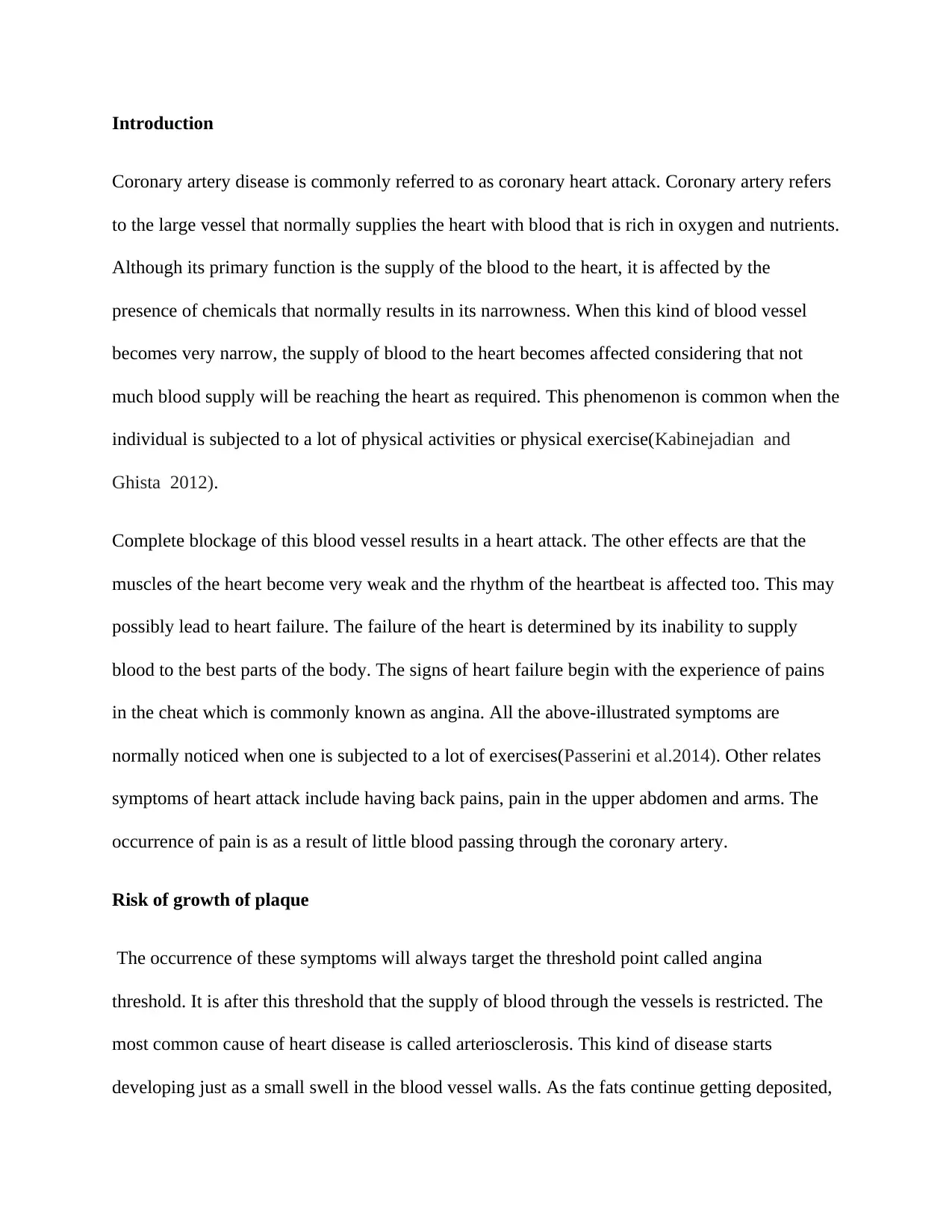
Introduction
Coronary artery disease is commonly referred to as coronary heart attack. Coronary artery refers
to the large vessel that normally supplies the heart with blood that is rich in oxygen and nutrients.
Although its primary function is the supply of the blood to the heart, it is affected by the
presence of chemicals that normally results in its narrowness. When this kind of blood vessel
becomes very narrow, the supply of blood to the heart becomes affected considering that not
much blood supply will be reaching the heart as required. This phenomenon is common when the
individual is subjected to a lot of physical activities or physical exercise(Kabinejadian and
Ghista 2012).
Complete blockage of this blood vessel results in a heart attack. The other effects are that the
muscles of the heart become very weak and the rhythm of the heartbeat is affected too. This may
possibly lead to heart failure. The failure of the heart is determined by its inability to supply
blood to the best parts of the body. The signs of heart failure begin with the experience of pains
in the cheat which is commonly known as angina. All the above-illustrated symptoms are
normally noticed when one is subjected to a lot of exercises(Passerini et al.2014). Other relates
symptoms of heart attack include having back pains, pain in the upper abdomen and arms. The
occurrence of pain is as a result of little blood passing through the coronary artery.
Risk of growth of plaque
The occurrence of these symptoms will always target the threshold point called angina
threshold. It is after this threshold that the supply of blood through the vessels is restricted. The
most common cause of heart disease is called arteriosclerosis. This kind of disease starts
developing just as a small swell in the blood vessel walls. As the fats continue getting deposited,
Coronary artery disease is commonly referred to as coronary heart attack. Coronary artery refers
to the large vessel that normally supplies the heart with blood that is rich in oxygen and nutrients.
Although its primary function is the supply of the blood to the heart, it is affected by the
presence of chemicals that normally results in its narrowness. When this kind of blood vessel
becomes very narrow, the supply of blood to the heart becomes affected considering that not
much blood supply will be reaching the heart as required. This phenomenon is common when the
individual is subjected to a lot of physical activities or physical exercise(Kabinejadian and
Ghista 2012).
Complete blockage of this blood vessel results in a heart attack. The other effects are that the
muscles of the heart become very weak and the rhythm of the heartbeat is affected too. This may
possibly lead to heart failure. The failure of the heart is determined by its inability to supply
blood to the best parts of the body. The signs of heart failure begin with the experience of pains
in the cheat which is commonly known as angina. All the above-illustrated symptoms are
normally noticed when one is subjected to a lot of exercises(Passerini et al.2014). Other relates
symptoms of heart attack include having back pains, pain in the upper abdomen and arms. The
occurrence of pain is as a result of little blood passing through the coronary artery.
Risk of growth of plaque
The occurrence of these symptoms will always target the threshold point called angina
threshold. It is after this threshold that the supply of blood through the vessels is restricted. The
most common cause of heart disease is called arteriosclerosis. This kind of disease starts
developing just as a small swell in the blood vessel walls. As the fats continue getting deposited,
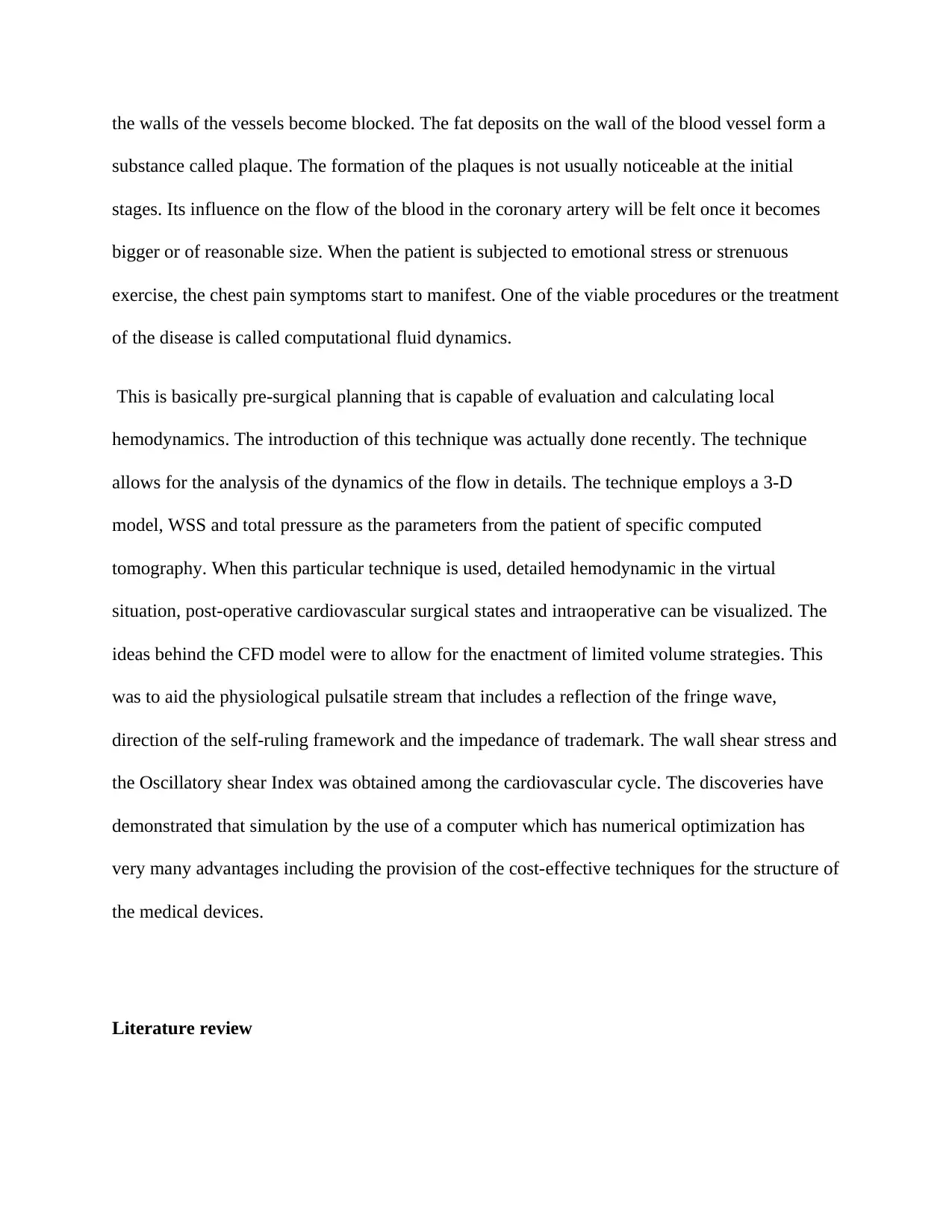
the walls of the vessels become blocked. The fat deposits on the wall of the blood vessel form a
substance called plaque. The formation of the plaques is not usually noticeable at the initial
stages. Its influence on the flow of the blood in the coronary artery will be felt once it becomes
bigger or of reasonable size. When the patient is subjected to emotional stress or strenuous
exercise, the chest pain symptoms start to manifest. One of the viable procedures or the treatment
of the disease is called computational fluid dynamics.
This is basically pre-surgical planning that is capable of evaluation and calculating local
hemodynamics. The introduction of this technique was actually done recently. The technique
allows for the analysis of the dynamics of the flow in details. The technique employs a 3-D
model, WSS and total pressure as the parameters from the patient of specific computed
tomography. When this particular technique is used, detailed hemodynamic in the virtual
situation, post-operative cardiovascular surgical states and intraoperative can be visualized. The
ideas behind the CFD model were to allow for the enactment of limited volume strategies. This
was to aid the physiological pulsatile stream that includes a reflection of the fringe wave,
direction of the self-ruling framework and the impedance of trademark. The wall shear stress and
the Oscillatory shear Index was obtained among the cardiovascular cycle. The discoveries have
demonstrated that simulation by the use of a computer which has numerical optimization has
very many advantages including the provision of the cost-effective techniques for the structure of
the medical devices.
Literature review
substance called plaque. The formation of the plaques is not usually noticeable at the initial
stages. Its influence on the flow of the blood in the coronary artery will be felt once it becomes
bigger or of reasonable size. When the patient is subjected to emotional stress or strenuous
exercise, the chest pain symptoms start to manifest. One of the viable procedures or the treatment
of the disease is called computational fluid dynamics.
This is basically pre-surgical planning that is capable of evaluation and calculating local
hemodynamics. The introduction of this technique was actually done recently. The technique
allows for the analysis of the dynamics of the flow in details. The technique employs a 3-D
model, WSS and total pressure as the parameters from the patient of specific computed
tomography. When this particular technique is used, detailed hemodynamic in the virtual
situation, post-operative cardiovascular surgical states and intraoperative can be visualized. The
ideas behind the CFD model were to allow for the enactment of limited volume strategies. This
was to aid the physiological pulsatile stream that includes a reflection of the fringe wave,
direction of the self-ruling framework and the impedance of trademark. The wall shear stress and
the Oscillatory shear Index was obtained among the cardiovascular cycle. The discoveries have
demonstrated that simulation by the use of a computer which has numerical optimization has
very many advantages including the provision of the cost-effective techniques for the structure of
the medical devices.
Literature review
⊘ This is a preview!⊘
Do you want full access?
Subscribe today to unlock all pages.

Trusted by 1+ million students worldwide
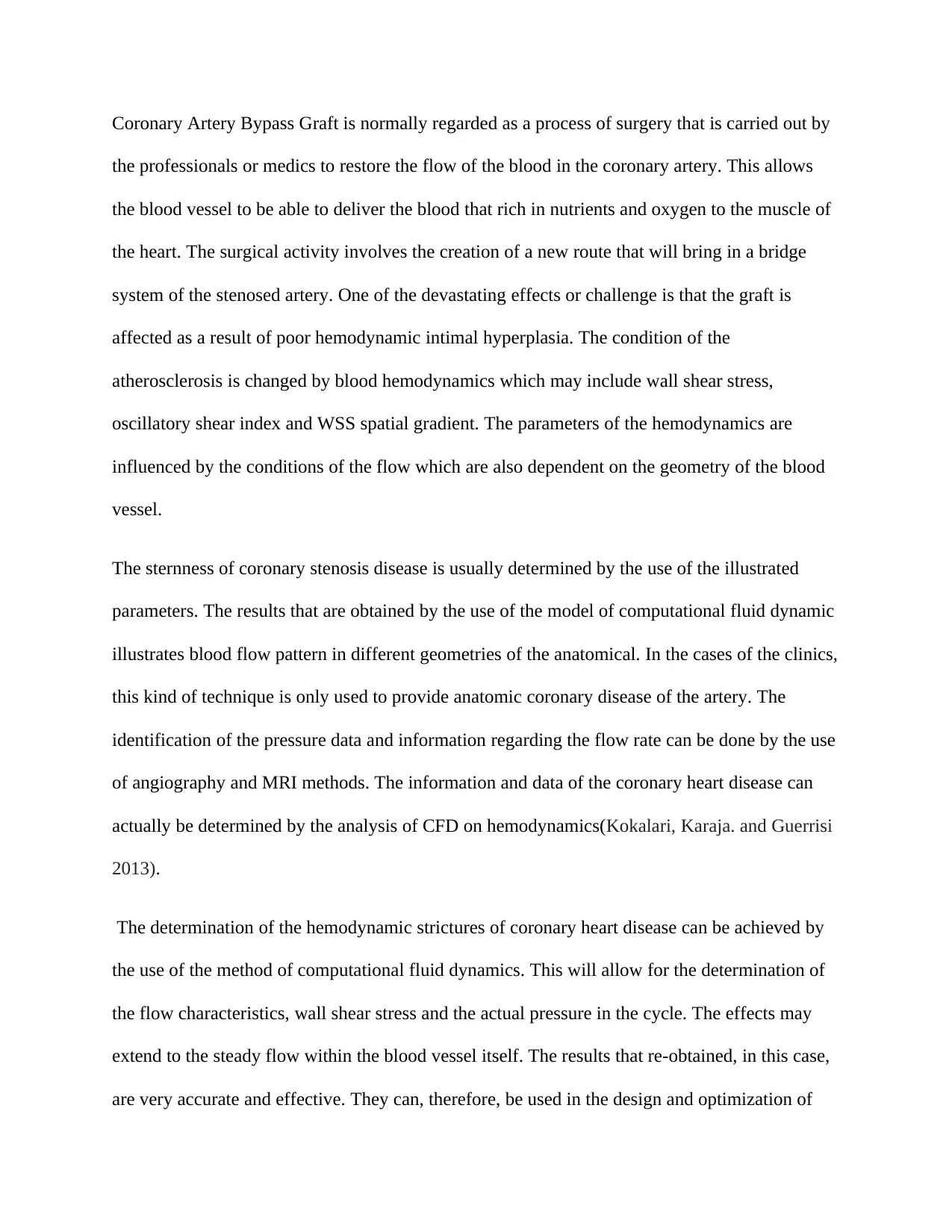
Coronary Artery Bypass Graft is normally regarded as a process of surgery that is carried out by
the professionals or medics to restore the flow of the blood in the coronary artery. This allows
the blood vessel to be able to deliver the blood that rich in nutrients and oxygen to the muscle of
the heart. The surgical activity involves the creation of a new route that will bring in a bridge
system of the stenosed artery. One of the devastating effects or challenge is that the graft is
affected as a result of poor hemodynamic intimal hyperplasia. The condition of the
atherosclerosis is changed by blood hemodynamics which may include wall shear stress,
oscillatory shear index and WSS spatial gradient. The parameters of the hemodynamics are
influenced by the conditions of the flow which are also dependent on the geometry of the blood
vessel.
The sternness of coronary stenosis disease is usually determined by the use of the illustrated
parameters. The results that are obtained by the use of the model of computational fluid dynamic
illustrates blood flow pattern in different geometries of the anatomical. In the cases of the clinics,
this kind of technique is only used to provide anatomic coronary disease of the artery. The
identification of the pressure data and information regarding the flow rate can be done by the use
of angiography and MRI methods. The information and data of the coronary heart disease can
actually be determined by the analysis of CFD on hemodynamics(Kokalari, Karaja. and Guerrisi
2013).
The determination of the hemodynamic strictures of coronary heart disease can be achieved by
the use of the method of computational fluid dynamics. This will allow for the determination of
the flow characteristics, wall shear stress and the actual pressure in the cycle. The effects may
extend to the steady flow within the blood vessel itself. The results that re-obtained, in this case,
are very accurate and effective. They can, therefore, be used in the design and optimization of
the professionals or medics to restore the flow of the blood in the coronary artery. This allows
the blood vessel to be able to deliver the blood that rich in nutrients and oxygen to the muscle of
the heart. The surgical activity involves the creation of a new route that will bring in a bridge
system of the stenosed artery. One of the devastating effects or challenge is that the graft is
affected as a result of poor hemodynamic intimal hyperplasia. The condition of the
atherosclerosis is changed by blood hemodynamics which may include wall shear stress,
oscillatory shear index and WSS spatial gradient. The parameters of the hemodynamics are
influenced by the conditions of the flow which are also dependent on the geometry of the blood
vessel.
The sternness of coronary stenosis disease is usually determined by the use of the illustrated
parameters. The results that are obtained by the use of the model of computational fluid dynamic
illustrates blood flow pattern in different geometries of the anatomical. In the cases of the clinics,
this kind of technique is only used to provide anatomic coronary disease of the artery. The
identification of the pressure data and information regarding the flow rate can be done by the use
of angiography and MRI methods. The information and data of the coronary heart disease can
actually be determined by the analysis of CFD on hemodynamics(Kokalari, Karaja. and Guerrisi
2013).
The determination of the hemodynamic strictures of coronary heart disease can be achieved by
the use of the method of computational fluid dynamics. This will allow for the determination of
the flow characteristics, wall shear stress and the actual pressure in the cycle. The effects may
extend to the steady flow within the blood vessel itself. The results that re-obtained, in this case,
are very accurate and effective. They can, therefore, be used in the design and optimization of
Paraphrase This Document
Need a fresh take? Get an instant paraphrase of this document with our AI Paraphraser
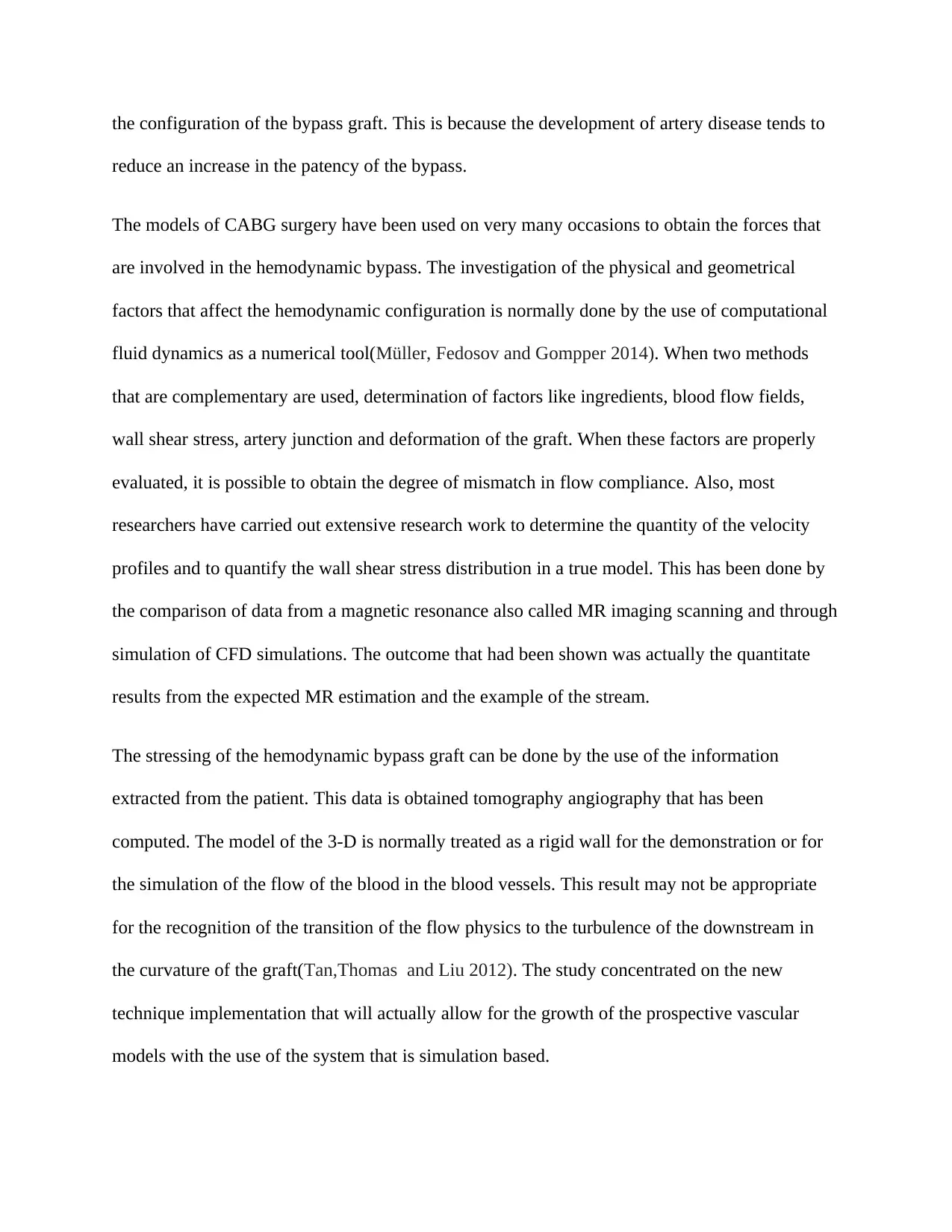
the configuration of the bypass graft. This is because the development of artery disease tends to
reduce an increase in the patency of the bypass.
The models of CABG surgery have been used on very many occasions to obtain the forces that
are involved in the hemodynamic bypass. The investigation of the physical and geometrical
factors that affect the hemodynamic configuration is normally done by the use of computational
fluid dynamics as a numerical tool(Müller, Fedosov and Gompper 2014). When two methods
that are complementary are used, determination of factors like ingredients, blood flow fields,
wall shear stress, artery junction and deformation of the graft. When these factors are properly
evaluated, it is possible to obtain the degree of mismatch in flow compliance. Also, most
researchers have carried out extensive research work to determine the quantity of the velocity
profiles and to quantify the wall shear stress distribution in a true model. This has been done by
the comparison of data from a magnetic resonance also called MR imaging scanning and through
simulation of CFD simulations. The outcome that had been shown was actually the quantitate
results from the expected MR estimation and the example of the stream.
The stressing of the hemodynamic bypass graft can be done by the use of the information
extracted from the patient. This data is obtained tomography angiography that has been
computed. The model of the 3-D is normally treated as a rigid wall for the demonstration or for
the simulation of the flow of the blood in the blood vessels. This result may not be appropriate
for the recognition of the transition of the flow physics to the turbulence of the downstream in
the curvature of the graft(Tan,Thomas and Liu 2012). The study concentrated on the new
technique implementation that will actually allow for the growth of the prospective vascular
models with the use of the system that is simulation based.
reduce an increase in the patency of the bypass.
The models of CABG surgery have been used on very many occasions to obtain the forces that
are involved in the hemodynamic bypass. The investigation of the physical and geometrical
factors that affect the hemodynamic configuration is normally done by the use of computational
fluid dynamics as a numerical tool(Müller, Fedosov and Gompper 2014). When two methods
that are complementary are used, determination of factors like ingredients, blood flow fields,
wall shear stress, artery junction and deformation of the graft. When these factors are properly
evaluated, it is possible to obtain the degree of mismatch in flow compliance. Also, most
researchers have carried out extensive research work to determine the quantity of the velocity
profiles and to quantify the wall shear stress distribution in a true model. This has been done by
the comparison of data from a magnetic resonance also called MR imaging scanning and through
simulation of CFD simulations. The outcome that had been shown was actually the quantitate
results from the expected MR estimation and the example of the stream.
The stressing of the hemodynamic bypass graft can be done by the use of the information
extracted from the patient. This data is obtained tomography angiography that has been
computed. The model of the 3-D is normally treated as a rigid wall for the demonstration or for
the simulation of the flow of the blood in the blood vessels. This result may not be appropriate
for the recognition of the transition of the flow physics to the turbulence of the downstream in
the curvature of the graft(Tan,Thomas and Liu 2012). The study concentrated on the new
technique implementation that will actually allow for the growth of the prospective vascular
models with the use of the system that is simulation based.
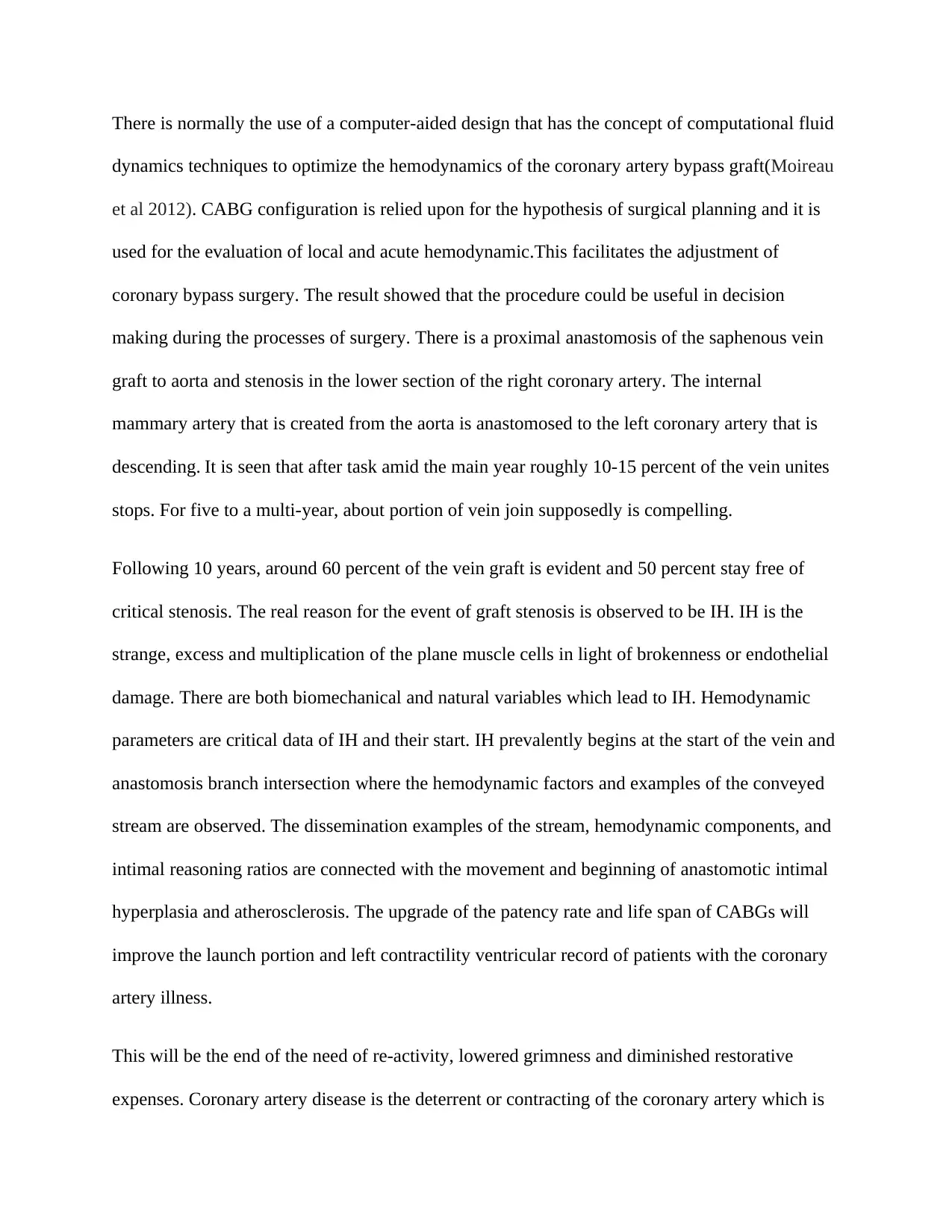
There is normally the use of a computer-aided design that has the concept of computational fluid
dynamics techniques to optimize the hemodynamics of the coronary artery bypass graft(Moireau
et al 2012). CABG configuration is relied upon for the hypothesis of surgical planning and it is
used for the evaluation of local and acute hemodynamic.This facilitates the adjustment of
coronary bypass surgery. The result showed that the procedure could be useful in decision
making during the processes of surgery. There is a proximal anastomosis of the saphenous vein
graft to aorta and stenosis in the lower section of the right coronary artery. The internal
mammary artery that is created from the aorta is anastomosed to the left coronary artery that is
descending. It is seen that after task amid the main year roughly 10-15 percent of the vein unites
stops. For five to a multi-year, about portion of vein join supposedly is compelling.
Following 10 years, around 60 percent of the vein graft is evident and 50 percent stay free of
critical stenosis. The real reason for the event of graft stenosis is observed to be IH. IH is the
strange, excess and multiplication of the plane muscle cells in light of brokenness or endothelial
damage. There are both biomechanical and natural variables which lead to IH. Hemodynamic
parameters are critical data of IH and their start. IH prevalently begins at the start of the vein and
anastomosis branch intersection where the hemodynamic factors and examples of the conveyed
stream are observed. The dissemination examples of the stream, hemodynamic components, and
intimal reasoning ratios are connected with the movement and beginning of anastomotic intimal
hyperplasia and atherosclerosis. The upgrade of the patency rate and life span of CABGs will
improve the launch portion and left contractility ventricular record of patients with the coronary
artery illness.
This will be the end of the need of re-activity, lowered grimness and diminished restorative
expenses. Coronary artery disease is the deterrent or contracting of the coronary artery which is
dynamics techniques to optimize the hemodynamics of the coronary artery bypass graft(Moireau
et al 2012). CABG configuration is relied upon for the hypothesis of surgical planning and it is
used for the evaluation of local and acute hemodynamic.This facilitates the adjustment of
coronary bypass surgery. The result showed that the procedure could be useful in decision
making during the processes of surgery. There is a proximal anastomosis of the saphenous vein
graft to aorta and stenosis in the lower section of the right coronary artery. The internal
mammary artery that is created from the aorta is anastomosed to the left coronary artery that is
descending. It is seen that after task amid the main year roughly 10-15 percent of the vein unites
stops. For five to a multi-year, about portion of vein join supposedly is compelling.
Following 10 years, around 60 percent of the vein graft is evident and 50 percent stay free of
critical stenosis. The real reason for the event of graft stenosis is observed to be IH. IH is the
strange, excess and multiplication of the plane muscle cells in light of brokenness or endothelial
damage. There are both biomechanical and natural variables which lead to IH. Hemodynamic
parameters are critical data of IH and their start. IH prevalently begins at the start of the vein and
anastomosis branch intersection where the hemodynamic factors and examples of the conveyed
stream are observed. The dissemination examples of the stream, hemodynamic components, and
intimal reasoning ratios are connected with the movement and beginning of anastomotic intimal
hyperplasia and atherosclerosis. The upgrade of the patency rate and life span of CABGs will
improve the launch portion and left contractility ventricular record of patients with the coronary
artery illness.
This will be the end of the need of re-activity, lowered grimness and diminished restorative
expenses. Coronary artery disease is the deterrent or contracting of the coronary artery which is
⊘ This is a preview!⊘
Do you want full access?
Subscribe today to unlock all pages.

Trusted by 1+ million students worldwide
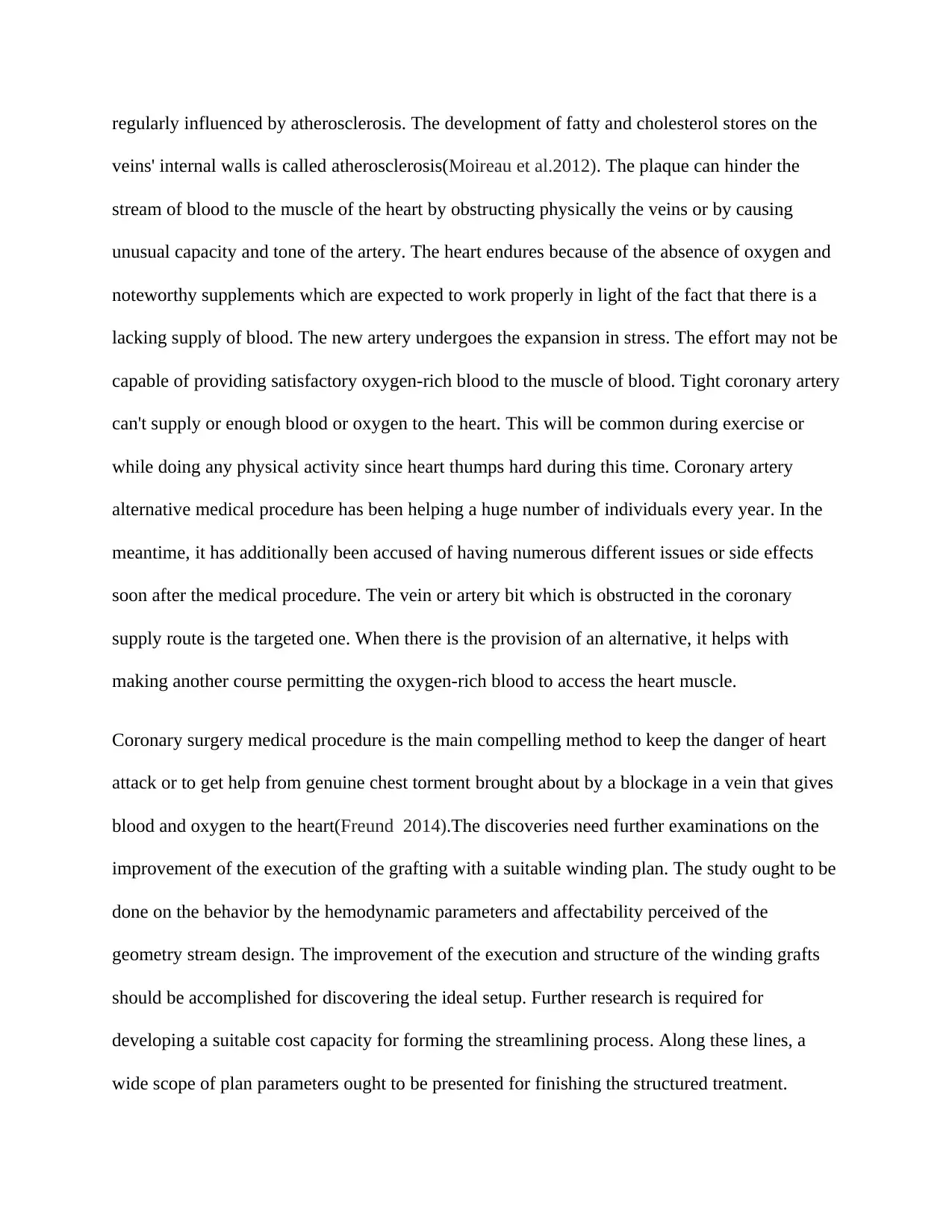
regularly influenced by atherosclerosis. The development of fatty and cholesterol stores on the
veins' internal walls is called atherosclerosis(Moireau et al.2012). The plaque can hinder the
stream of blood to the muscle of the heart by obstructing physically the veins or by causing
unusual capacity and tone of the artery. The heart endures because of the absence of oxygen and
noteworthy supplements which are expected to work properly in light of the fact that there is a
lacking supply of blood. The new artery undergoes the expansion in stress. The effort may not be
capable of providing satisfactory oxygen-rich blood to the muscle of blood. Tight coronary artery
can't supply or enough blood or oxygen to the heart. This will be common during exercise or
while doing any physical activity since heart thumps hard during this time. Coronary artery
alternative medical procedure has been helping a huge number of individuals every year. In the
meantime, it has additionally been accused of having numerous different issues or side effects
soon after the medical procedure. The vein or artery bit which is obstructed in the coronary
supply route is the targeted one. When there is the provision of an alternative, it helps with
making another course permitting the oxygen-rich blood to access the heart muscle.
Coronary surgery medical procedure is the main compelling method to keep the danger of heart
attack or to get help from genuine chest torment brought about by a blockage in a vein that gives
blood and oxygen to the heart(Freund 2014).The discoveries need further examinations on the
improvement of the execution of the grafting with a suitable winding plan. The study ought to be
done on the behavior by the hemodynamic parameters and affectability perceived of the
geometry stream design. The improvement of the execution and structure of the winding grafts
should be accomplished for discovering the ideal setup. Further research is required for
developing a suitable cost capacity for forming the streamlining process. Along these lines, a
wide scope of plan parameters ought to be presented for finishing the structured treatment.
veins' internal walls is called atherosclerosis(Moireau et al.2012). The plaque can hinder the
stream of blood to the muscle of the heart by obstructing physically the veins or by causing
unusual capacity and tone of the artery. The heart endures because of the absence of oxygen and
noteworthy supplements which are expected to work properly in light of the fact that there is a
lacking supply of blood. The new artery undergoes the expansion in stress. The effort may not be
capable of providing satisfactory oxygen-rich blood to the muscle of blood. Tight coronary artery
can't supply or enough blood or oxygen to the heart. This will be common during exercise or
while doing any physical activity since heart thumps hard during this time. Coronary artery
alternative medical procedure has been helping a huge number of individuals every year. In the
meantime, it has additionally been accused of having numerous different issues or side effects
soon after the medical procedure. The vein or artery bit which is obstructed in the coronary
supply route is the targeted one. When there is the provision of an alternative, it helps with
making another course permitting the oxygen-rich blood to access the heart muscle.
Coronary surgery medical procedure is the main compelling method to keep the danger of heart
attack or to get help from genuine chest torment brought about by a blockage in a vein that gives
blood and oxygen to the heart(Freund 2014).The discoveries need further examinations on the
improvement of the execution of the grafting with a suitable winding plan. The study ought to be
done on the behavior by the hemodynamic parameters and affectability perceived of the
geometry stream design. The improvement of the execution and structure of the winding grafts
should be accomplished for discovering the ideal setup. Further research is required for
developing a suitable cost capacity for forming the streamlining process. Along these lines, a
wide scope of plan parameters ought to be presented for finishing the structured treatment.
Paraphrase This Document
Need a fresh take? Get an instant paraphrase of this document with our AI Paraphraser
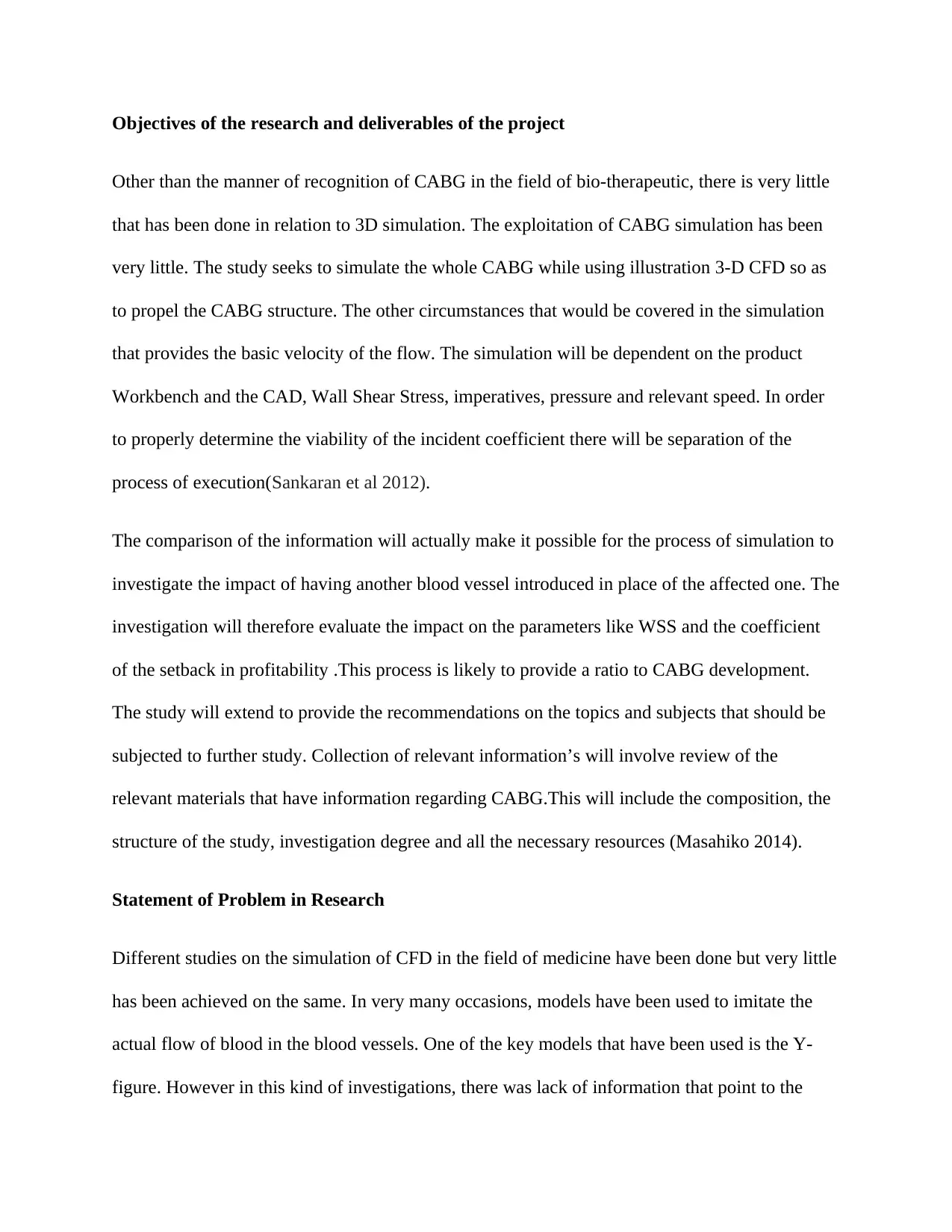
Objectives of the research and deliverables of the project
Other than the manner of recognition of CABG in the field of bio-therapeutic, there is very little
that has been done in relation to 3D simulation. The exploitation of CABG simulation has been
very little. The study seeks to simulate the whole CABG while using illustration 3-D CFD so as
to propel the CABG structure. The other circumstances that would be covered in the simulation
that provides the basic velocity of the flow. The simulation will be dependent on the product
Workbench and the CAD, Wall Shear Stress, imperatives, pressure and relevant speed. In order
to properly determine the viability of the incident coefficient there will be separation of the
process of execution(Sankaran et al 2012).
The comparison of the information will actually make it possible for the process of simulation to
investigate the impact of having another blood vessel introduced in place of the affected one. The
investigation will therefore evaluate the impact on the parameters like WSS and the coefficient
of the setback in profitability .This process is likely to provide a ratio to CABG development.
The study will extend to provide the recommendations on the topics and subjects that should be
subjected to further study. Collection of relevant information’s will involve review of the
relevant materials that have information regarding CABG.This will include the composition, the
structure of the study, investigation degree and all the necessary resources (Masahiko 2014).
Statement of Problem in Research
Different studies on the simulation of CFD in the field of medicine have been done but very little
has been achieved on the same. In very many occasions, models have been used to imitate the
actual flow of blood in the blood vessels. One of the key models that have been used is the Y-
figure. However in this kind of investigations, there was lack of information that point to the
Other than the manner of recognition of CABG in the field of bio-therapeutic, there is very little
that has been done in relation to 3D simulation. The exploitation of CABG simulation has been
very little. The study seeks to simulate the whole CABG while using illustration 3-D CFD so as
to propel the CABG structure. The other circumstances that would be covered in the simulation
that provides the basic velocity of the flow. The simulation will be dependent on the product
Workbench and the CAD, Wall Shear Stress, imperatives, pressure and relevant speed. In order
to properly determine the viability of the incident coefficient there will be separation of the
process of execution(Sankaran et al 2012).
The comparison of the information will actually make it possible for the process of simulation to
investigate the impact of having another blood vessel introduced in place of the affected one. The
investigation will therefore evaluate the impact on the parameters like WSS and the coefficient
of the setback in profitability .This process is likely to provide a ratio to CABG development.
The study will extend to provide the recommendations on the topics and subjects that should be
subjected to further study. Collection of relevant information’s will involve review of the
relevant materials that have information regarding CABG.This will include the composition, the
structure of the study, investigation degree and all the necessary resources (Masahiko 2014).
Statement of Problem in Research
Different studies on the simulation of CFD in the field of medicine have been done but very little
has been achieved on the same. In very many occasions, models have been used to imitate the
actual flow of blood in the blood vessels. One of the key models that have been used is the Y-
figure. However in this kind of investigations, there was lack of information that point to the
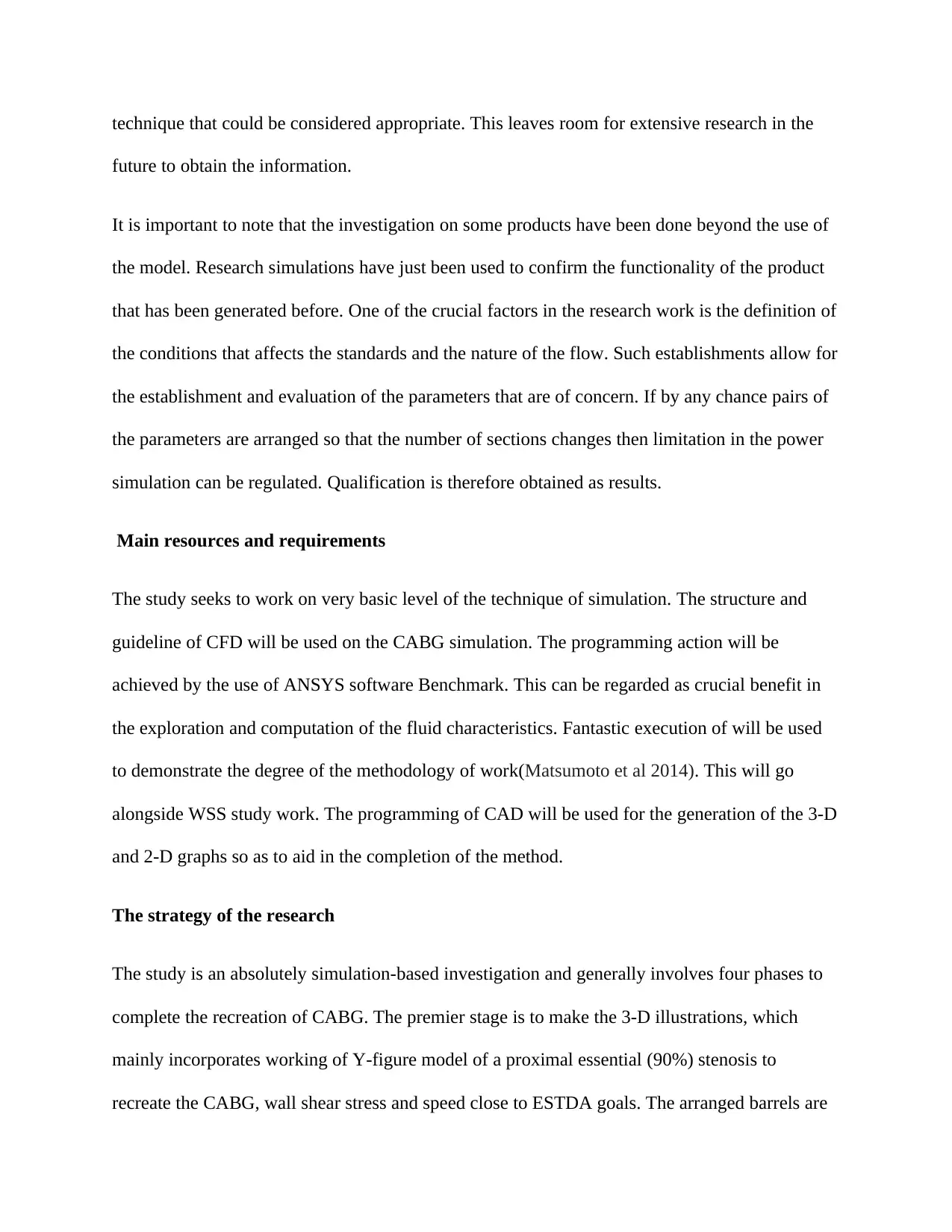
technique that could be considered appropriate. This leaves room for extensive research in the
future to obtain the information.
It is important to note that the investigation on some products have been done beyond the use of
the model. Research simulations have just been used to confirm the functionality of the product
that has been generated before. One of the crucial factors in the research work is the definition of
the conditions that affects the standards and the nature of the flow. Such establishments allow for
the establishment and evaluation of the parameters that are of concern. If by any chance pairs of
the parameters are arranged so that the number of sections changes then limitation in the power
simulation can be regulated. Qualification is therefore obtained as results.
Main resources and requirements
The study seeks to work on very basic level of the technique of simulation. The structure and
guideline of CFD will be used on the CABG simulation. The programming action will be
achieved by the use of ANSYS software Benchmark. This can be regarded as crucial benefit in
the exploration and computation of the fluid characteristics. Fantastic execution of will be used
to demonstrate the degree of the methodology of work(Matsumoto et al 2014). This will go
alongside WSS study work. The programming of CAD will be used for the generation of the 3-D
and 2-D graphs so as to aid in the completion of the method.
The strategy of the research
The study is an absolutely simulation-based investigation and generally involves four phases to
complete the recreation of CABG. The premier stage is to make the 3-D illustrations, which
mainly incorporates working of Y-figure model of a proximal essential (90%) stenosis to
recreate the CABG, wall shear stress and speed close to ESTDA goals. The arranged barrels are
future to obtain the information.
It is important to note that the investigation on some products have been done beyond the use of
the model. Research simulations have just been used to confirm the functionality of the product
that has been generated before. One of the crucial factors in the research work is the definition of
the conditions that affects the standards and the nature of the flow. Such establishments allow for
the establishment and evaluation of the parameters that are of concern. If by any chance pairs of
the parameters are arranged so that the number of sections changes then limitation in the power
simulation can be regulated. Qualification is therefore obtained as results.
Main resources and requirements
The study seeks to work on very basic level of the technique of simulation. The structure and
guideline of CFD will be used on the CABG simulation. The programming action will be
achieved by the use of ANSYS software Benchmark. This can be regarded as crucial benefit in
the exploration and computation of the fluid characteristics. Fantastic execution of will be used
to demonstrate the degree of the methodology of work(Matsumoto et al 2014). This will go
alongside WSS study work. The programming of CAD will be used for the generation of the 3-D
and 2-D graphs so as to aid in the completion of the method.
The strategy of the research
The study is an absolutely simulation-based investigation and generally involves four phases to
complete the recreation of CABG. The premier stage is to make the 3-D illustrations, which
mainly incorporates working of Y-figure model of a proximal essential (90%) stenosis to
recreate the CABG, wall shear stress and speed close to ESTDA goals. The arranged barrels are
⊘ This is a preview!⊘
Do you want full access?
Subscribe today to unlock all pages.

Trusted by 1+ million students worldwide
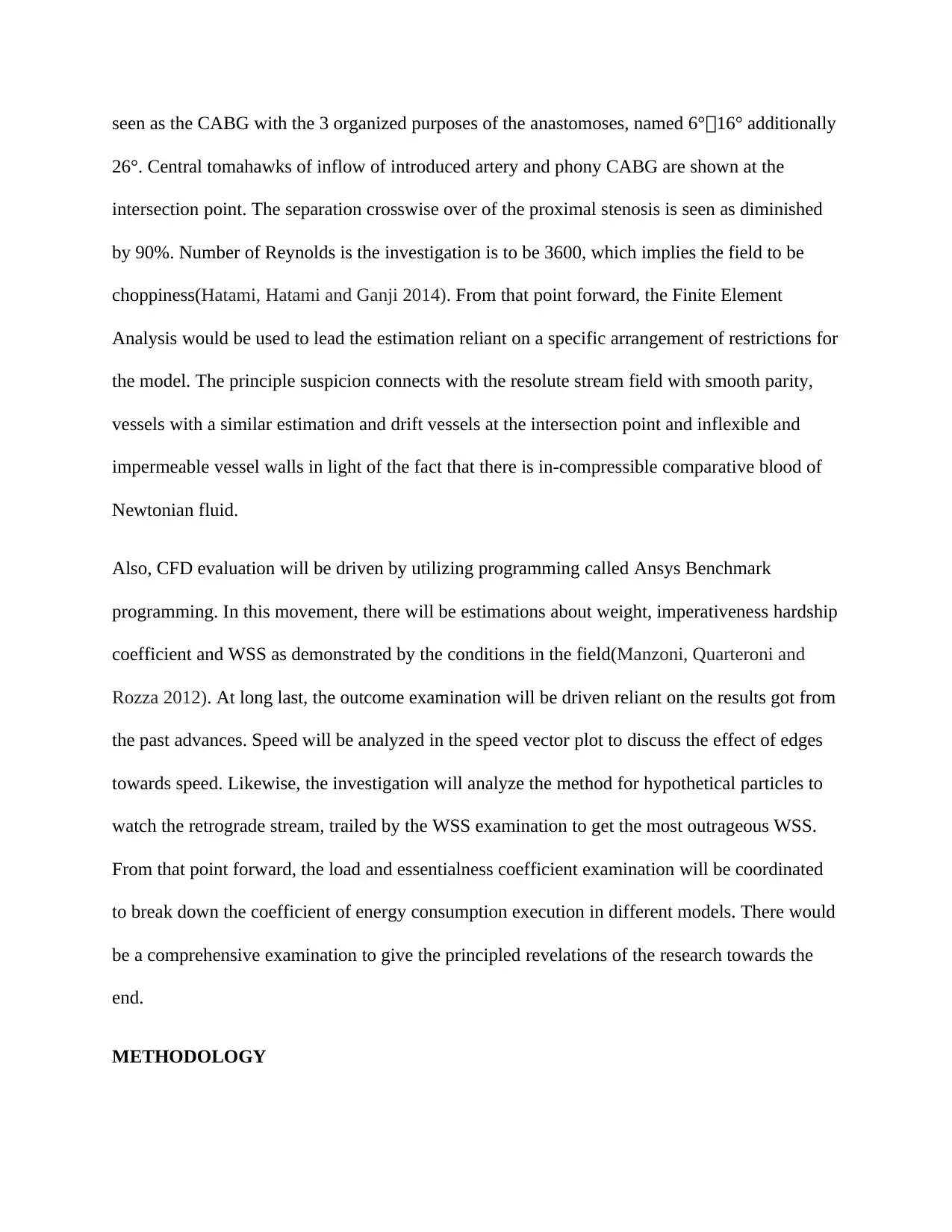
seen as the CABG with the 3 organized purposes of the anastomoses, named 6°,16° additionally
26°. Central tomahawks of inflow of introduced artery and phony CABG are shown at the
intersection point. The separation crosswise over of the proximal stenosis is seen as diminished
by 90%. Number of Reynolds is the investigation is to be 3600, which implies the field to be
choppiness(Hatami, Hatami and Ganji 2014). From that point forward, the Finite Element
Analysis would be used to lead the estimation reliant on a specific arrangement of restrictions for
the model. The principle suspicion connects with the resolute stream field with smooth parity,
vessels with a similar estimation and drift vessels at the intersection point and inflexible and
impermeable vessel walls in light of the fact that there is in-compressible comparative blood of
Newtonian fluid.
Also, CFD evaluation will be driven by utilizing programming called Ansys Benchmark
programming. In this movement, there will be estimations about weight, imperativeness hardship
coefficient and WSS as demonstrated by the conditions in the field(Manzoni, Quarteroni and
Rozza 2012). At long last, the outcome examination will be driven reliant on the results got from
the past advances. Speed will be analyzed in the speed vector plot to discuss the effect of edges
towards speed. Likewise, the investigation will analyze the method for hypothetical particles to
watch the retrograde stream, trailed by the WSS examination to get the most outrageous WSS.
From that point forward, the load and essentialness coefficient examination will be coordinated
to break down the coefficient of energy consumption execution in different models. There would
be a comprehensive examination to give the principled revelations of the research towards the
end.
METHODOLOGY
26°. Central tomahawks of inflow of introduced artery and phony CABG are shown at the
intersection point. The separation crosswise over of the proximal stenosis is seen as diminished
by 90%. Number of Reynolds is the investigation is to be 3600, which implies the field to be
choppiness(Hatami, Hatami and Ganji 2014). From that point forward, the Finite Element
Analysis would be used to lead the estimation reliant on a specific arrangement of restrictions for
the model. The principle suspicion connects with the resolute stream field with smooth parity,
vessels with a similar estimation and drift vessels at the intersection point and inflexible and
impermeable vessel walls in light of the fact that there is in-compressible comparative blood of
Newtonian fluid.
Also, CFD evaluation will be driven by utilizing programming called Ansys Benchmark
programming. In this movement, there will be estimations about weight, imperativeness hardship
coefficient and WSS as demonstrated by the conditions in the field(Manzoni, Quarteroni and
Rozza 2012). At long last, the outcome examination will be driven reliant on the results got from
the past advances. Speed will be analyzed in the speed vector plot to discuss the effect of edges
towards speed. Likewise, the investigation will analyze the method for hypothetical particles to
watch the retrograde stream, trailed by the WSS examination to get the most outrageous WSS.
From that point forward, the load and essentialness coefficient examination will be coordinated
to break down the coefficient of energy consumption execution in different models. There would
be a comprehensive examination to give the principled revelations of the research towards the
end.
METHODOLOGY
Paraphrase This Document
Need a fresh take? Get an instant paraphrase of this document with our AI Paraphraser
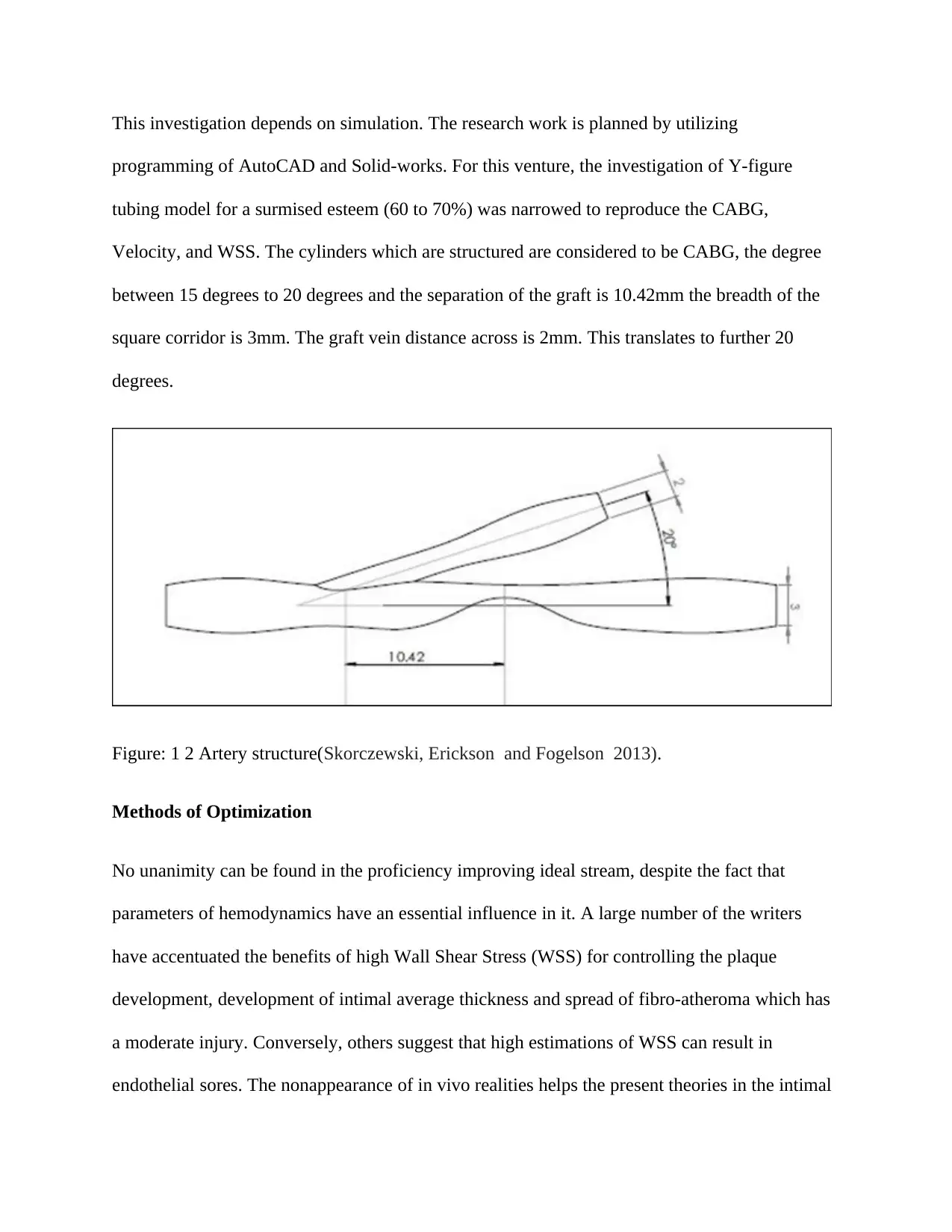
This investigation depends on simulation. The research work is planned by utilizing
programming of AutoCAD and Solid-works. For this venture, the investigation of Y-figure
tubing model for a surmised esteem (60 to 70%) was narrowed to reproduce the CABG,
Velocity, and WSS. The cylinders which are structured are considered to be CABG, the degree
between 15 degrees to 20 degrees and the separation of the graft is 10.42mm the breadth of the
square corridor is 3mm. The graft vein distance across is 2mm. This translates to further 20
degrees.
Figure: 1 2 Artery structure(Skorczewski, Erickson and Fogelson 2013).
Methods of Optimization
No unanimity can be found in the proficiency improving ideal stream, despite the fact that
parameters of hemodynamics have an essential influence in it. A large number of the writers
have accentuated the benefits of high Wall Shear Stress (WSS) for controlling the plaque
development, development of intimal average thickness and spread of fibro-atheroma which has
a moderate injury. Conversely, others suggest that high estimations of WSS can result in
endothelial sores. The nonappearance of in vivo realities helps the present theories in the intimal
programming of AutoCAD and Solid-works. For this venture, the investigation of Y-figure
tubing model for a surmised esteem (60 to 70%) was narrowed to reproduce the CABG,
Velocity, and WSS. The cylinders which are structured are considered to be CABG, the degree
between 15 degrees to 20 degrees and the separation of the graft is 10.42mm the breadth of the
square corridor is 3mm. The graft vein distance across is 2mm. This translates to further 20
degrees.
Figure: 1 2 Artery structure(Skorczewski, Erickson and Fogelson 2013).
Methods of Optimization
No unanimity can be found in the proficiency improving ideal stream, despite the fact that
parameters of hemodynamics have an essential influence in it. A large number of the writers
have accentuated the benefits of high Wall Shear Stress (WSS) for controlling the plaque
development, development of intimal average thickness and spread of fibro-atheroma which has
a moderate injury. Conversely, others suggest that high estimations of WSS can result in
endothelial sores. The nonappearance of in vivo realities helps the present theories in the intimal
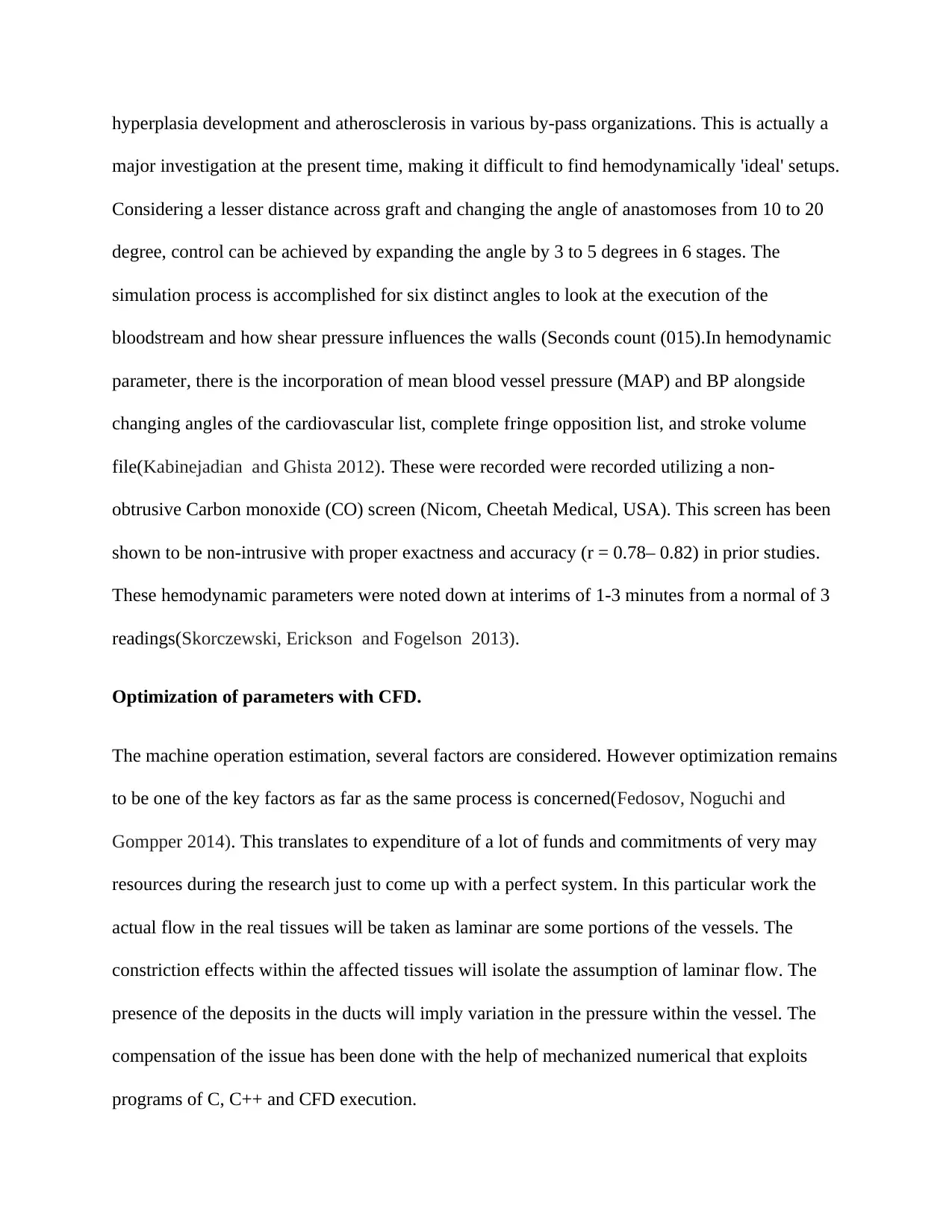
hyperplasia development and atherosclerosis in various by-pass organizations. This is actually a
major investigation at the present time, making it difficult to find hemodynamically 'ideal' setups.
Considering a lesser distance across graft and changing the angle of anastomoses from 10 to 20
degree, control can be achieved by expanding the angle by 3 to 5 degrees in 6 stages. The
simulation process is accomplished for six distinct angles to look at the execution of the
bloodstream and how shear pressure influences the walls (Seconds count (015).In hemodynamic
parameter, there is the incorporation of mean blood vessel pressure (MAP) and BP alongside
changing angles of the cardiovascular list, complete fringe opposition list, and stroke volume
file(Kabinejadian and Ghista 2012). These were recorded were recorded utilizing a non-
obtrusive Carbon monoxide (CO) screen (Nicom, Cheetah Medical, USA). This screen has been
shown to be non-intrusive with proper exactness and accuracy (r = 0.78– 0.82) in prior studies.
These hemodynamic parameters were noted down at interims of 1-3 minutes from a normal of 3
readings(Skorczewski, Erickson and Fogelson 2013).
Optimization of parameters with CFD.
The machine operation estimation, several factors are considered. However optimization remains
to be one of the key factors as far as the same process is concerned(Fedosov, Noguchi and
Gompper 2014). This translates to expenditure of a lot of funds and commitments of very may
resources during the research just to come up with a perfect system. In this particular work the
actual flow in the real tissues will be taken as laminar are some portions of the vessels. The
constriction effects within the affected tissues will isolate the assumption of laminar flow. The
presence of the deposits in the ducts will imply variation in the pressure within the vessel. The
compensation of the issue has been done with the help of mechanized numerical that exploits
programs of C, C++ and CFD execution.
major investigation at the present time, making it difficult to find hemodynamically 'ideal' setups.
Considering a lesser distance across graft and changing the angle of anastomoses from 10 to 20
degree, control can be achieved by expanding the angle by 3 to 5 degrees in 6 stages. The
simulation process is accomplished for six distinct angles to look at the execution of the
bloodstream and how shear pressure influences the walls (Seconds count (015).In hemodynamic
parameter, there is the incorporation of mean blood vessel pressure (MAP) and BP alongside
changing angles of the cardiovascular list, complete fringe opposition list, and stroke volume
file(Kabinejadian and Ghista 2012). These were recorded were recorded utilizing a non-
obtrusive Carbon monoxide (CO) screen (Nicom, Cheetah Medical, USA). This screen has been
shown to be non-intrusive with proper exactness and accuracy (r = 0.78– 0.82) in prior studies.
These hemodynamic parameters were noted down at interims of 1-3 minutes from a normal of 3
readings(Skorczewski, Erickson and Fogelson 2013).
Optimization of parameters with CFD.
The machine operation estimation, several factors are considered. However optimization remains
to be one of the key factors as far as the same process is concerned(Fedosov, Noguchi and
Gompper 2014). This translates to expenditure of a lot of funds and commitments of very may
resources during the research just to come up with a perfect system. In this particular work the
actual flow in the real tissues will be taken as laminar are some portions of the vessels. The
constriction effects within the affected tissues will isolate the assumption of laminar flow. The
presence of the deposits in the ducts will imply variation in the pressure within the vessel. The
compensation of the issue has been done with the help of mechanized numerical that exploits
programs of C, C++ and CFD execution.
⊘ This is a preview!⊘
Do you want full access?
Subscribe today to unlock all pages.

Trusted by 1+ million students worldwide
1 out of 26
Related Documents
Your All-in-One AI-Powered Toolkit for Academic Success.
+13062052269
info@desklib.com
Available 24*7 on WhatsApp / Email
![[object Object]](/_next/static/media/star-bottom.7253800d.svg)
Unlock your academic potential
Copyright © 2020–2025 A2Z Services. All Rights Reserved. Developed and managed by ZUCOL.





